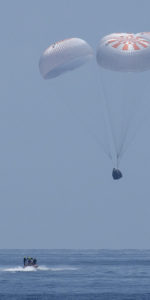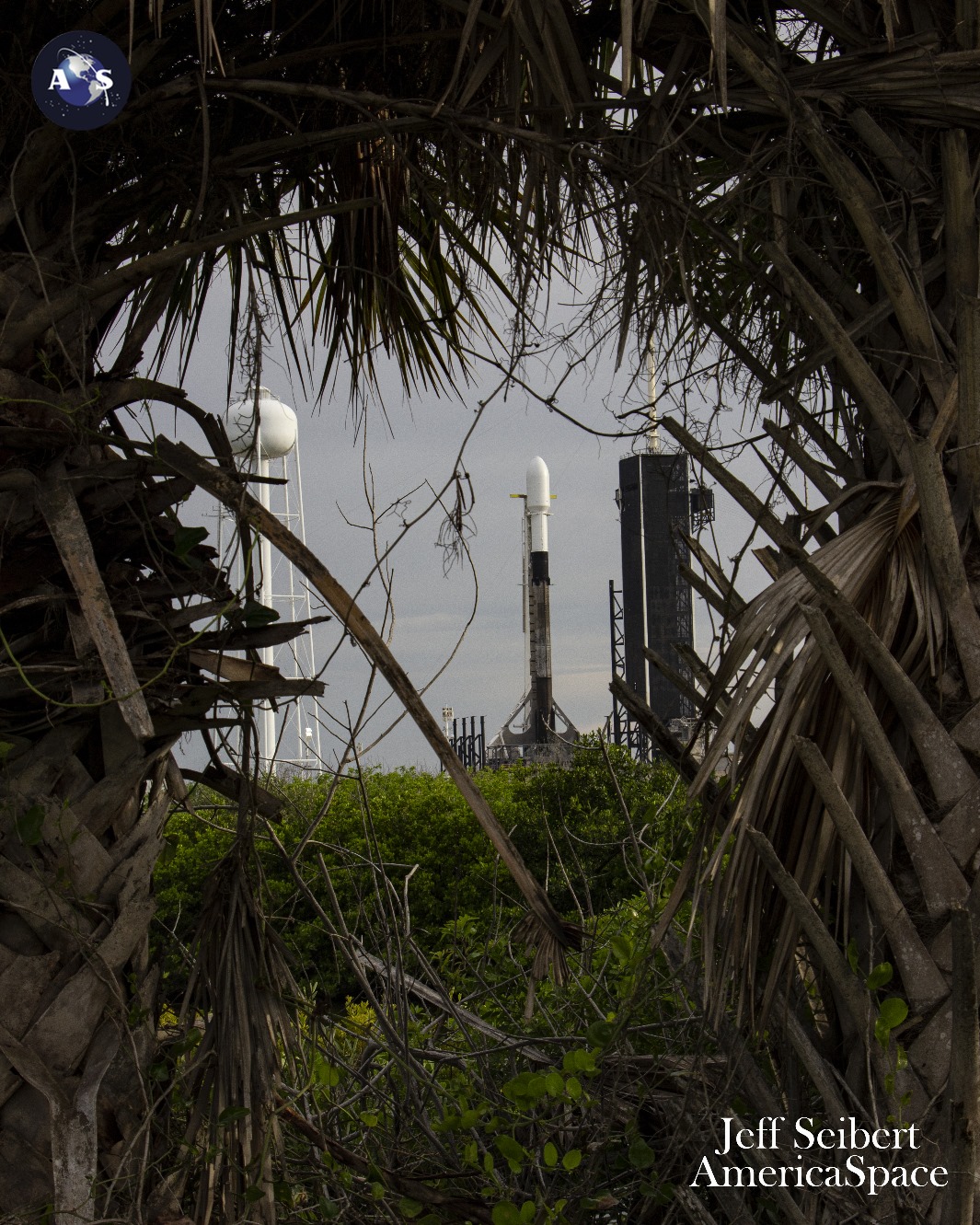
Having already seen seven batches of Starlinks launched in the first six months of the year—a total of 418 satellites all told—it could hardly be imagined that we space-watchers would grow to miss the regular cadence of these low-orbiting internet communications providers roaring skyward atop SpaceX Falcon 9s from the Space Coast. But the next launch, scheduled to occur from historic Pad 39A at the Kennedy Space Center (KSC), no sooner than 1:12 a.m. EDT Friday, 7 August, will be the first such mission in almost two months. And with an unenviable three launch scrubs on its record, the long-awaited Starlink/BlackSky mission almost appears snakebitten by the gods of cruel fortune.
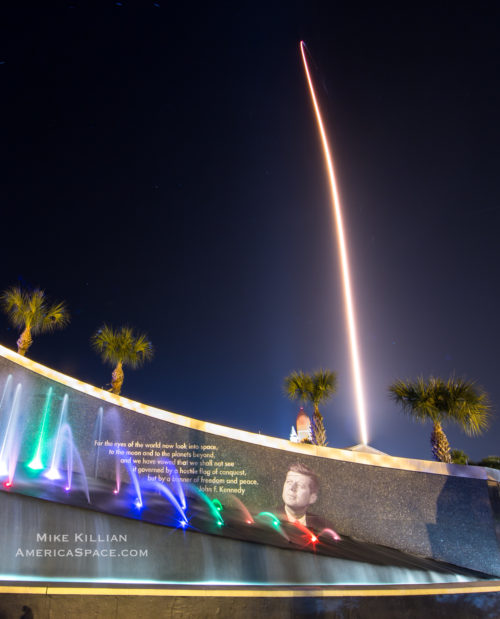
The previously-flown B1051 core has been waiting in the wings since the end of June to launch 57 more Starlinks and the Global-5 and Global-6 Earth-imaging satellites for Spaceflight, Inc.’s customer, BlackSky, Inc. Delayed on no fewer than three occasions due to poor weather and technical issues, the mission was progressively leapfrogged by the launches of a major Global Positioning System (GPS) Block III mission for the U.S. Space Force and more recently South Korea’s first secure military communications satellite, the heavyweight ANASIS-II.
Originally scheduled to occur on 26 June, ahead of the GPS III-03 launch, a combination of insufficient time and an iffy weather forecast ultimately conspired against the mission. Blackened and scarred from four previous ascents and high-energy re-entries, the B1051 core and a brand-new second stage were trundled out to Pad 39A and completed a customary Static Fire Test of its nine Merlin 1D+ first-stage engines on 24 June. B1051 will become only the third Falcon 9 core to fly five times. It first flew in March 2019 to deliver SpaceX’s historic Demo-1 Crew Dragon to the International Space Station (ISS), then went on to loft Canada’s three-satellite Radarsat Constellation Mission (RCM) the following June and a pair of Starlink batches in late January and, most recently, on 22 April.
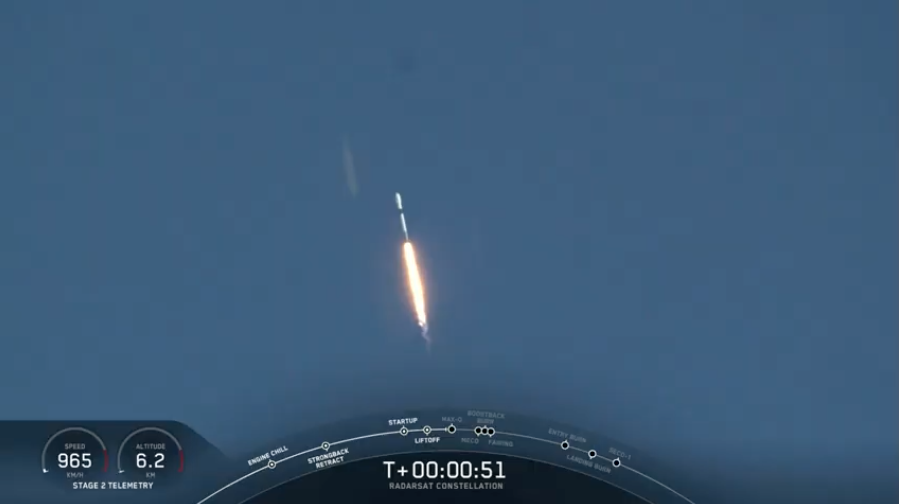
But 26 June’s attempt was scrubbed three hours before the targeted liftoff, with SpaceX citing a need for “additional time for pre-launch checkouts” and stressing that both the rocket and its payload remained in good health. With the high-priority GPS III-03 mission satisfactorily completed from neighboring Space Launch Complex (SLC)-40 at Cape Canaveral Air Force Station on 30 June, the Starlink/BlackSky mission correspondingly moved into pole position, targeting a new launch attempt on 8 July.
But that attempt was also called off, shortly after the onset of fueling, and with only ten minutes remaining in the countdown, as the intractable Florida weather rolled in. Curiously, although SpaceX noted that weather was indeed the driving factor behind 8 July’s scrub, it added that it would continue counting down to T-1 minute “for data collection”. This produced a rather odd state of affairs, as clocks continued to tick towards a launch that everyone knew would not come to pass. A third attempt on 11 July was similarly scrubbed, less than two hours before T-0, in order to “allow more time for checkouts”. A few days later, on the 15th, the hapless B1051 was rotated horizontal and trundled back to the Horizontal Integration Facility (HIF) for additional work. In keeping with SpaceX’s tradition, nothing has been revealed about what (if any) corrective actions or repairs were executed on the booster or its payload.
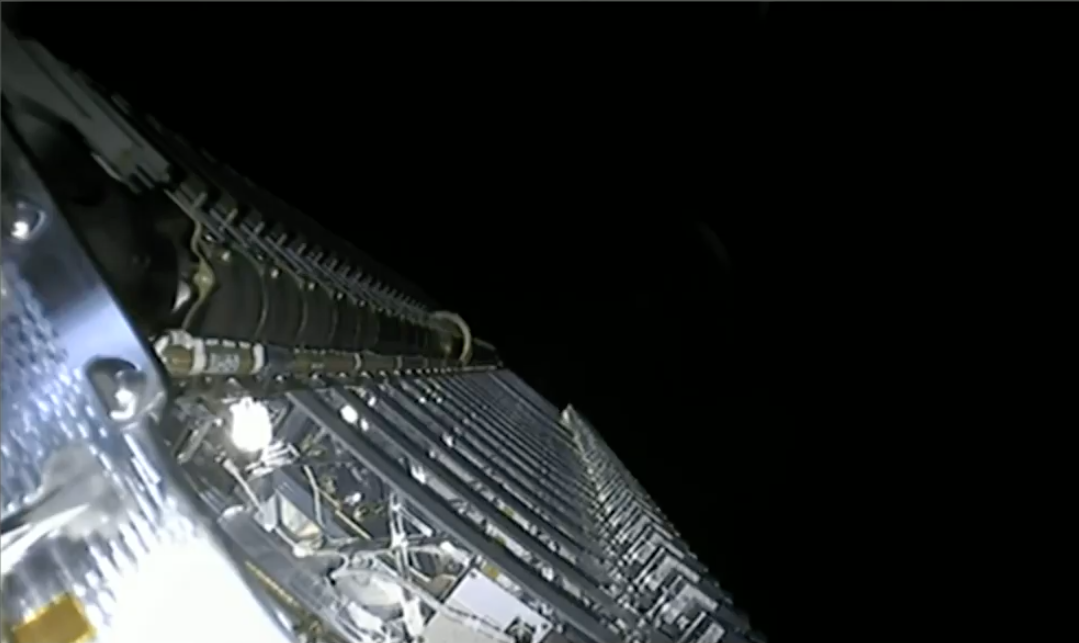
Hopes of launching at month’s end also came to nothing, as all eyes focused on NASA’s launch of the Perseverance rover and Ingenuity helicopter to Mars atop United Launch Alliance’s (ULA) Atlas V on the 30th. The appearance of Tropical Storm Isaias and its steady evolution into a Category 1 hurricane has also not aided the launch-weather picture, striking Hispaniola, Puerto Rico and the Bahamas and beginning to threaten the United States’ eastern seaboard by early August. How this will impact not only Friday’s launch attempt, but also the anticipated recovery of B1051 by the Autonomous Spaceport Drone Ship (ASDS), “Of Course I Still Love You”, remains to be seen.
In its L-3 weather briefing, issued Monday, the 45th Weather Squadron at Patrick Air Force Base noted a diminishing influence of Isaias as it progresses away from the Florida and up the eastern seaboard. “Weak high-pressure will rebuild across the area by mid-week in the wake of the storm,” it was noted, “with light winds allowing the east-coast sea-breeze to develop each afternoon.” But with lingering tropical moisture from Isaias, there remain “high shower and storm chances and cloud cover”, which affords a 70-percent chance on Friday. “The primary weather concern for launch day will be leftover debris clouds from earlier convection, along with a few showers in the vicinity with cumulus clouds,” the 45th concluded.
Primary payload for the mission are 57 Starlink satellites, all equipped with “VisorSat” optical-darkening technology to limit their visibility in the night sky and corresponding impact upon astronomy. The $10 billion Starlink program, unveiled by SpaceX CEO Elon Musk in Seattle, Wash., in January 2015, is predicted to revolutionize low-cost broadband internet provision. He identified it as a means of opening the way for competitively-priced services for urban regions and rural and underserved areas of the United States. Under the announced plan, an eventual constellation of 12,000 satellites could handle up to half of all backhaul communications traffic and a tenth of all local internet traffic in high-population-density cities by the mid-2020s.
Late in 2016, SpaceX described the concept as “non-geostationary” and revealed Starlink’s initial coverage would span the Ku-band and Ka-band regions, between 12-18 GHz and 26.5-40 GHz, respectively. By the late spring of the following year, plans were laid for a second orbital “shell” of satellites to utilize the V-band at 40-75 GHz, which is not routinely used for commercial communications purposes. Previously, the V-band has seen service for millimeter-wave radar research and scientific applications, but it reportedly also has promise for high-capacity terrestrial millimeter-wave communications networks.
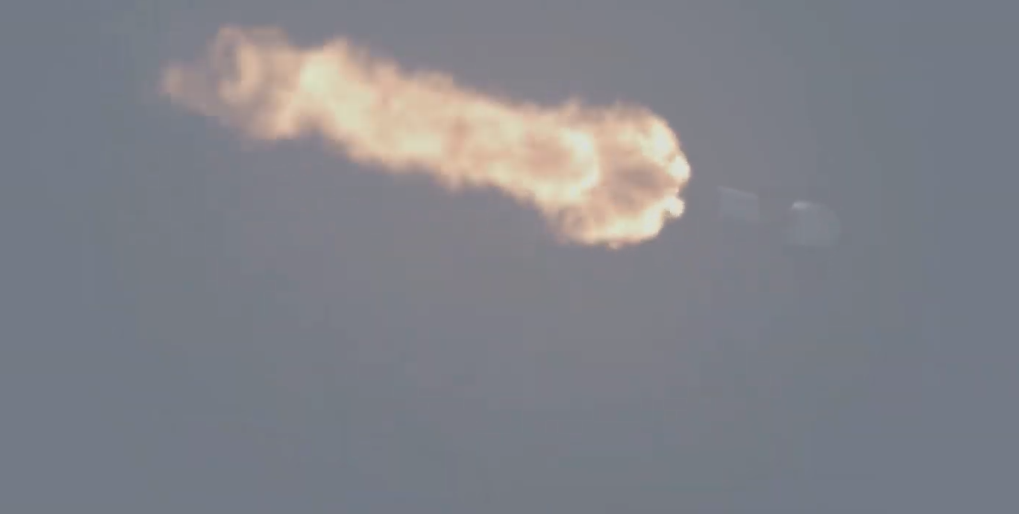
SpaceX’s original intent was for 4,425 Ku-/Ka-band Starlinks to reside at an altitude of 710 miles (1,150 km) and 7,518 V-band birds to sit at 210 miles (340 km), producing a total population of these small satellites by the mid-2020s. However, in November 2018 SpaceX received licensing from the Federal Communications Commission (FCC) to operate a third of the Ku-/Ka-band complement—some 1,584 satellites—at just 340 miles (550 km), much lower than initially planned. This will produce a relatively short operational lifetime of around five years, before they are maneuvered into a disposal orbit for controlled re-entry. SpaceX has explained that all satellite components are “100-percent demisable” and exceed “all current safety standards”, but the sheer volume of Starlinks to be launched in a relatively short period has aroused lingering controversy, both in terms of the work of astronomers and adding to ongoing debate about the effect of space debris.
Two Starlink test satellites, Tintin-A and Tintin-B, were launched in February 2018 and successfully validated the phased-array broadband antenna from an orbital perch 320 miles (515 km) above Earth. Then in May 2019, the first 60 “production-design” Starlink satellites were launched. Although three of the satellites failed shortly after reaching orbit, the remainder are still healthy. More recently, in November 2019 and on seven occasions to date in 2020 further batches of Starlinks were boosted aloft. SpaceX President Gwynne Shotwell has already confirmed plans to launch further 60-strong sets of Starlinks approximately every two weeks throughout the rest of the year.
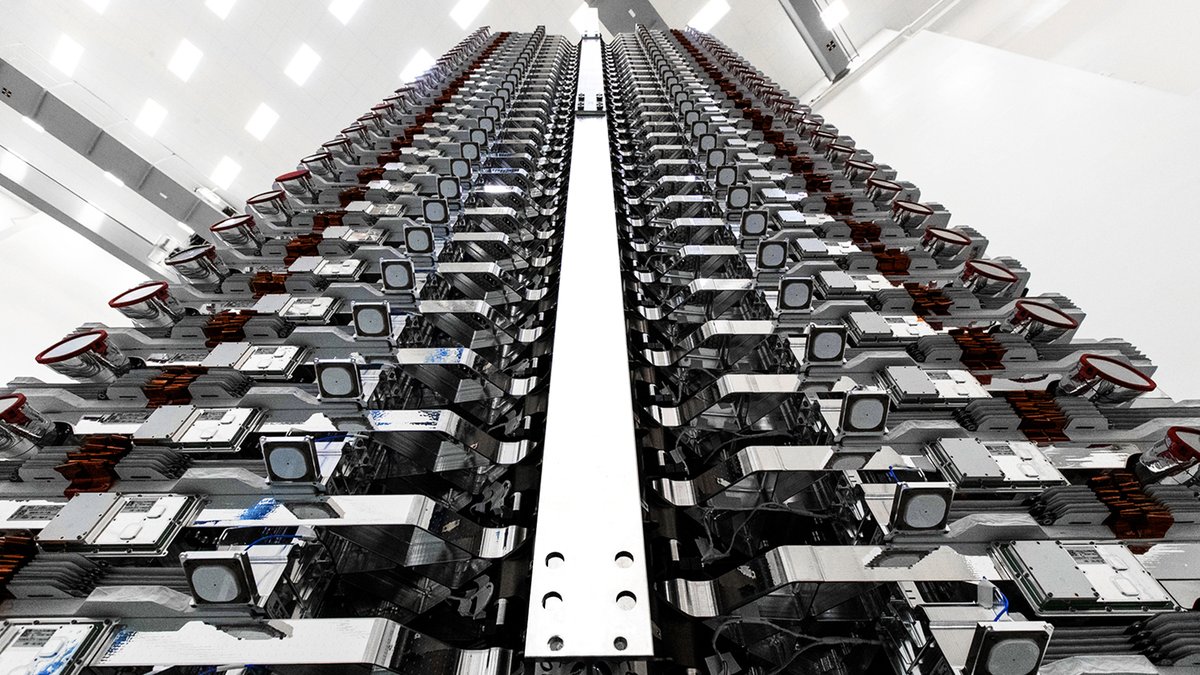
But Friday’s mission also carries a pair of “rideshare” passengers—known as Global-5 and Global-6—which are both devoted to Earth observations and are flying on behalf of Spaceflight, Inc.’s customer, BlackSky, Inc. They have been built in Seattle, Wash., by LeoStella, a joint venture between Spaceflight, Inc., and Thales Alenia Space. The first pair of Global birds flew atop a previous Falcon 9 in December 2018, part of Spaceflight’s SSO-A SmallSat Express payload, whilst the second pair followed them to orbit in June 2019 atop an Elektron-KS booster from Onenui Station on New Zealand’s North Island.
These satellites have the capacity to provide a ground-imaging resolution as fine as 3.3 feet (1 meter) from an altitude of 310 miles (500 km). Weighing approximately 120 pounds (56 kg), Global-5 and Global-6 are correspondingly the next members in what BlackSky hopes will evolve into a 60-strong satellite constellation with the ability to rapidly revisit the same locations on Earth every 10-15 minutes. According to Spaceflight, Inc., this mission is designated “SXRS-1”, in recognition of its nature as the first SpaceX Rideshare. And in June the company announced that it had inked agreements with SpaceX “to secure rideshare capacity on multiple launches”, which will permit the manifesting of payloads on “several” Falcon 9 missions through the end of 2021.




